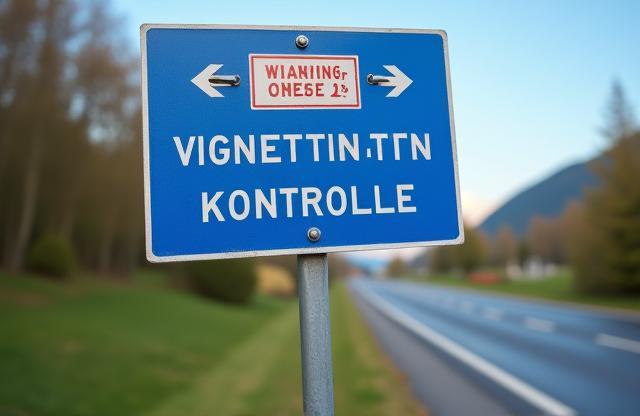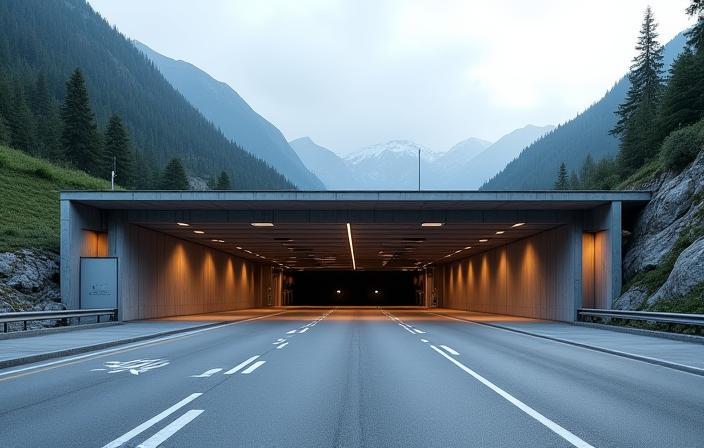
Österreich Vignette: Your Essential Guide
Navigate Austria's motorways and expressways confidently. Everything you need to know about required road tolls and how to comply.

Navigate Austria's motorways and expressways confidently. Everything you need to know about required road tolls and how to comply.
The Österreich Vignette, often simply referred to as the Austrian vignette, is a mandatory toll payment system for most vehicles using Austria's extensive network of motorways (Autobahnen) and expressways (Schnellstraßen). Established as a user-pays principle, this system ensures that those who benefit directly from using these high-quality roads contribute to their upkeep, expansion, and modernization.
Unlike traditional toll booths encountered in some countries, the vignette grants you the right to use the entire vignette-mandatory network for a specific duration, regardless of how many times you enter or exit it within that period. This streamlines traffic flow and reduces congestion at entry/exit points that would otherwise require payment collection.
Introduced initially as a physical sticker, the system has evolved with the introduction of the digital vignette, offering travelers and residents a convenient electronic alternative. This digital version is linked directly to your vehicle's license plate number, eliminating the need for physical attachment and making compliance simpler, especially for frequent visitors or those renting cars.
Adherence to the vignette requirement is paramount when driving on designated Austrian roads. The system is rigorously enforced through automated checks and mobile patrols by authorities like ASFINAG (the Austrian motorway and expressway operator) and the police. Failure to display a valid physical vignette correctly or have a valid digital vignette registered for your vehicle and license plate carries substantial penalties, significantly exceeding the cost of the vignette itself.
Therefore, understanding how the vignette system works, knowing where it is required, and ensuring you have the correct and valid entitlement before starting your journey on these roads is not just about compliance; it's about avoiding unnecessary stress, delays, and costly fines, ensuring a smooth and legal driving experience throughout Austria's beautiful landscapes.


Driving on any motorway (Autobahn) or expressway (Schnellstraße) in Austria designated as requiring a vignette without having purchased and validated the appropriate vignette is a direct violation of federal law. These roads are clearly marked at entry points, and the obligation is absolute for vehicles under 3.5 tonnes.
Authorities, primarily ASFINAG toll inspectors and the Austrian police, conduct frequent and often discreet checks. These can range from roadside stops to sophisticated automated camera systems that scan license plates, particularly at border crossings, tunnels, and motorway exits. The system is designed to detect non-compliance efficiently and effectively.
If you are intercepted or detected driving without a valid vignette, the consequences are severe. You will be issued a mandatory fixed penalty fine (called an 'Ersatzmaut'). This fine is significantly higher than the cost of an annual vignette and must typically be paid on the spot. Failure to pay can lead to further legal action and even vehicle impoundment in extreme cases for non-residents.
Furthermore, there are specific rules regarding the correct placement of a physical vignette (clearly visible on the windscreen) and the correct registration of a digital vignette (correct license plate, validity period matching travel dates). An incorrectly affixed physical vignette or an erroneously entered license plate for a digital one is also considered invalid, potentially leading to the same penalties. Ensuring meticulous attention to detail when purchasing and applying/registering your vignette is therefore essential for a trouble-free journey on Austria's major road network.
The pricing structure for the Österreich Vignette is based on the type of vehicle you are operating and the length of time you require access to the vignette-mandatory network. Different vehicle categories, primarily motorcycles and vehicles up to 3.5 tonnes (cars, motorhomes, etc.), have distinct pricing tiers reflecting their usage impact.
The most common durations available for purchase are tailored to suit various travel needs, from short holiday trips to regular commutes or long-term stays. Understanding these options helps you select the most economical and appropriate vignette for your journey plan:
Important Disclaimer: The prices for these vignettes are set annually by the Austrian federal government and are subject to change. The information provided here details the types of vignettes available by duration and vehicle category for informational purposes only. For the most current, precise pricing, you **must** consult official Austrian sources such as the ASFINAG website or authorized points of sale before making your purchase. This site does not provide current pricing data.
To ensure legitimacy and avoid counterfeit vignettes, it is absolutely crucial to purchase your vignette exclusively from official and authorized distribution channels.
The traditional physical sticker remains a widely used option. These stickers are tangible proof of payment and must be correctly affixed to your vehicle before entering any vignette-mandatory road. They are available at numerous convenient locations, particularly near borders and on common travel routes:
Correct Affixing is Mandatory: For cars, the sticker must be placed on the inside of the windscreen, typically in the upper left corner or behind the rear-view mirror. For motorcycles, it must be on a visible, non-removable part of the vehicle. Failure to affix it correctly renders the vignette invalid and can lead to fines.

The digital vignette offers a modern, paperless alternative linked directly to your vehicle's license plate. This is particularly convenient as it requires no physical handling or affixing. It's the preferred method for many regular travelers and rental car users:
Important 18-Day Waiting Period (for Consumers): When purchased online or via app by a consumer (not a business), the digital vignette is NOT valid immediately. Due to consumer protection laws granting a right of withdrawal, there is a mandatory 18-day waiting period before the digital vignette becomes valid. Plan your purchase well in advance of your travel date if you opt for the digital version as a private individual. This waiting period does not apply to purchases made as a registered business.
While the standard vignette covers the vast majority of Austria's motorway and expressway network, there are specific sections and structures that require an *additional*, separate toll payment. These are typically routes featuring expensive and complex engineering works, such as long tunnels, high alpine passes, or specific bridge crossings.
These special toll routes are clearly marked and function independently of the vignette system. Having a valid vignette **does not** grant free passage on these specific routes. You will need to pay the required toll either physically at a toll plaza located before entering the section or digitally in advance via the official ASFINAG digital route section toll system.
Key Special Toll Routes in Austria:
Always check your intended route carefully using a reliable route planner before traveling in Austria to identify any special toll sections you might encounter and plan for payment accordingly.

The Österreich Vignette is a compulsory user fee required for most vehicles weighing up to 3.5 tonnes that use Austria's designated motorways (Autobahnen) and expressways (Schnellstraßen). It serves as a system to fund the maintenance and development of these key routes. It exists in two forms: a physical sticker that must be affixed to the windscreen or a digital entitlement linked to your vehicle's license plate number.
The cost of the vignette is determined by the Austrian government and varies based on your vehicle type (e.g., car, motorcycle) and the duration of validity you choose (10 days, 2 months, or a full year). Prices are subject to change annually. For the most current and accurate pricing information, you must consult official sources like the ASFINAG website or authorized physical points of sale. This site provides general information about the system, not current pricing.
You can purchase the physical vignette sticker at various official locations, including petrol stations and Trafiken (tobacco shops) in Austria, automobile clubs (like ÖAMTC, ARBÖ), and often at service stations or kiosks near border crossings just before entering Austria. The digital vignette can be bought conveniently online via the official ASFINAG webshop or through their dedicated mobile app. Remember the 18-day waiting period for digital vignettes purchased by consumers.
Driving on a vignette-mandatory road in Austria without a correctly validated vignette (either physical and properly affixed, or digital and correctly registered) is a serious legal infraction. Authorities conduct frequent checks, both manual and automated. If caught, you will be issued a fixed penalty fine (Ersatzmaut), which is substantially higher than the cost of purchasing the vignette itself. Ignoring this requirement can lead to significant financial penalties.
Yes, in addition to the vignette for general motorway/expressway use, several specific routes in Austria require a separate, additional toll. These typically include expensive infrastructure like long tunnels (e.g., Brenner, Tauern, Gleinalm) and certain high alpine roads. A valid vignette does not cover these special toll sections. You need to pay the specific route toll at a toll station or via the digital route section toll system.
Austrian vignettes are available in three standard validity periods: a 10-day vignette, a 2-month vignette, and an annual vignette. The annual vignette is valid for a 14-month period, from December 1st of the preceding year until January 31st of the following year. The specific validity starts from the date of purchase (for physical, often marked) or the chosen start date (for digital, subject to waiting period).
Functionally, both the physical and digital vignettes serve the same purpose: granting you legal access to the vignette-mandatory road network. The primary difference is the format and how they are linked to your vehicle. The physical vignette is a sticker you apply to your vehicle's windscreen (or a visible part for motorcycles). The digital vignette is electronic and linked to your license plate number, eliminating the need for a physical sticker. For consumers buying digitally, there is a mandatory 18-day waiting period for validity to start, which does not apply to physical stickers or business digital purchases.
No, vignettes are generally not transferable between vehicles. A physical vignette, once correctly affixed, cannot be removed and reused on another vehicle; attempting to remove it destroys its validity. A digital vignette is electronically linked to a specific license plate number and cannot be transferred to a different license plate or vehicle. If you change vehicles, you will need to purchase a new vignette for the new vehicle.
The vignette is required for most vehicles with a maximum permissible weight of up to 3.5 tonnes that use vignette-mandatory roads. This includes passenger cars, motorcycles, and lighter motorhomes. Vehicles exceeding 3.5 tonnes (such as heavy trucks and larger motorhomes) use a separate, distance-based electronic toll system called the 'GO Box' and do not require a vignette.
Yes, motorcycles using vignette-mandatory motorways and expressways in Austria are required to have a valid vignette. Specific vignette categories and prices exist for motorcycles, distinct from cars. There are also specific rules on where the motorcycle vignette must be affixed (a visible, non-removable part).

While this website aims to be a comprehensive informational resource regarding the Österreich Vignette system, specific individual circumstances or complex travel plans might lead to further questions. We are here to provide assistance based on the general information available.
For direct inquiries, please contact us via phone:
Please note: We recommend calling during standard Austrian business hours for the best availability.
For questions requiring official confirmation or specific legal advice regarding tolls and penalties, it is always recommended to consult the official Austrian authorities (ASFINAG) directly.